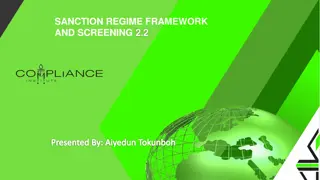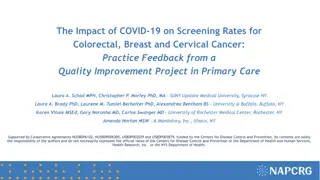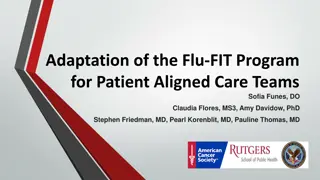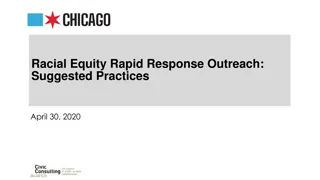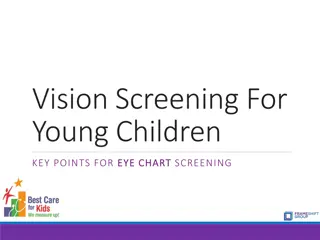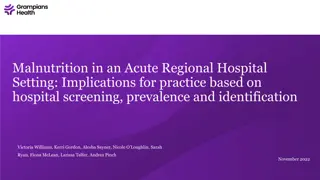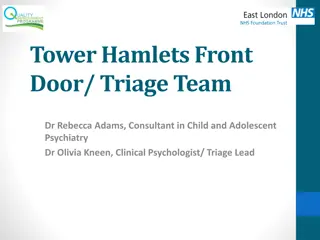Strategic and Creative Re-Engineering of Integrated Planning Team - Pre-Screening Tools and Requirements
Assisting in the development of pre-screening tools and requirements for integrated planning, this initiative aims to enhance collaboration among members of the Southwest Power Pool (SPP) to ensure reliable energy supply now and in the future. The project involves a structured timeline, with key milestones in baseline schedule setting, stakeholder engagement, development, and feedback sessions. Objectives include streamlining planning processes, consolidating IT processes, and developing tools for system reliability and hosting capacity assessments to support effective decision-making.
Download Presentation

Please find below an Image/Link to download the presentation.
The content on the website is provided AS IS for your information and personal use only. It may not be sold, licensed, or shared on other websites without obtaining consent from the author. Download presentation by click this link. If you encounter any issues during the download, it is possible that the publisher has removed the file from their server.
E N D
Presentation Transcript
STRATEGIC AND CREATIVE RE-ENGINEERING OF INTEGRATED PLANNING TEAM (SCRIPT) PRE-SCREENING TOOLS AND REQUIREMENTS JULY, 2023 Helping our members work together to keep the lights on... today and in the future. SPPorg southwest-power-pool SouthwestPowerPool
OBJECTIVE SCRIPT Pre-screening tools and requirements Schedule Overview Feedback 2
PRE-SCREENING TOOLS TIMELINE Set Baseline Schedule* 8/31 Estimated Go-Live 10/3 CPP Phase 1 Start Q1 2025 2023 2025 Jan Apr Jul Oct 2024 Apr Jul Oct 2025 Today Requirements & Design Apr 1 - Aug 31 Stakeholder Demos & Feedback Jul 1 - Oct 31 Development & Testing (internal & external) Sep 1 - Aug 31 Stakeholder Demos & Feedback Jan 1 - Apr 30 CPP Phase 1 Start (Q1 2025) Jan 1 - Mar 31 * Dates below the setting of the baseline schedule are estimated target dates. 3
OVERVIEW GI Backlog and GI Manual Efforts CPP Goal Develop a planning process that consolidates ITP, AQ, and GI. ITP Economics, Reliability, and Policy GI Reliability AQ Reliability Economics = reliability planning for real time operation of system Why bring real time operation of system into GI? How best to bring real time operation of system into GI? Hosting Capacity Tool Goal Develop a tool that identifies system limits and approximate stand alone costs consistent as possible to what may be identified in the CPP Initial Reliability Assessments 4
GI BACKLOG AND GI MANUAL EFFORTS 5
POTENTIAL RISKS? GI BACKLOG MITIGATION/RESOURCE ADEQUACY Transfer Analysis Methodologies and Potential Implications Less<---------------Deterministic Scenario Severity------------------->More Less<----------------------Study Time and Effort----------------------->More Less<------------------------Model Build Issues------------------------->More Less<--------------Base Case and Transfer Case Violations------------>More Less<-------------------Price of New Interconnections----------------->More Less<-----------------------------Withdraws------------------------------>More Less<-----------------------------Restudies------------------------------->More requests Subregional - Limit to system near interconnection Request and use Redispatch as a solution to direct entry fee to Regional Component and lessen impacts of withdrawn Withdraws and Restudies pose risks to CPP study success and resource adequacy Unplanned Change to Process In Development In Production Consolidated Planning Process (ERIS/CRIS/AQ Transfer Analysis Methodologies) Option 1 Option 2 Option 3 Before FBD (Approved FBD Balanced for New Solar, Storage, and Wind) (TWG Adjusted FBD-Existing Wind Focused) (Evergy Adjusted FBD- Existing Wind Focused) 6
RELEVANT GIMTF PUNCH LIST ITEMS FBD Impact Visual Example Only Generation Interconnection Manual Task Force Punch list Items (Top 2 Items) Dispatch assumptions Base Case Violations Interdependent items that impact the supply and price of new interconnections S e v e r e Base Case Violations Base Case Violations represent need for system redispatch from a real-time operations perspective Option 2 Increases likelihood of Base Case and Transfer Case Violations and Increases price of new interconnections M o d e r a t e M i l d Before FBD Option 2 After FBD 7
HOW ARE WE DOING? GI 3-PHASE DISIS PROCESS 3-Phase + BMP continue to see faster progress compared with legacy COMPARISON OF THE 3-PHASE+BACKLOG MITIGATION WITH THE LEGACY PROCESS 1 1 1 1 1 1 1 Option 2 increases likelihood of restudies as a result of delayed withdrawals due to interconnection customer s seeking the lowest cost of network upgrade requirements 88% 86% 81% 79% Legacy Studies 77% Percent of Initial Requests 71% 70% 67% 70% 69% 67% 65% Three-Phase +BMP Studies 63% 62% 62% 58% 58% 58% 54% 53% 53% 46% 44% 43% 41% 41% 37% 36% 35% 31% 4 30% 10 0 1 2 3 5 6 7 8 9 8 Study Iteration DISIS-2017-001 DISIS-2015-002 DISIS-2016-001 DISIS-2016-002 DISIS-2017-002 DISIS-2018-001 DISIS-2018-002/2019-001
GENERATION EXPECTED TO COME ONLINE BY COMMERCIAL OPERATION DATE Executed GIA future generation, not in commercial operation: 14.5 GW 70000 60000 Option 2 increases likelihood withdraws and restudies decreasing the % of Study Queue generation expected to come line by commercial operation dates 50000 40000 30000 20000 10000 0 2023 2024 2025 2026 2027 2028 2029 Executed GIA Active Study GIA + 40% of Study Queue Cumulative Generation 9 https://www.spp.org/engineering/generator-interconnection/
RR493 RECOMMENDED WORK PLAN TO ADD SENSITIVITIES FOR CPP PREPARATION Workplan to identify process changes or improvements for Consolidated Planning Process Preparation to address: Cumulative impact concerns for Grouping of requests, specifically Group 1 and 5 Cumulative impact concerns for Grouping of requests, specifically Group 1 and 5 Flowgates Flowgates specific to interconnection service (Versus Integration of resources into real specific to interconnection service (Versus Integration of resources into real time operation) time operation) Incorporation of Incorporation of redispatch redispatch as a reliable non as a reliable non- -transmission solution Aligning FBD percentages to Accredited Capacity values per fuel type (solar, wind, battery) Expansion of electrically equivalent criteria Integration of Short Circuit Ratio and Critical Clearing Time ( SCRCCT ) screening and EMT studies and other Inverter Based Resource integration study recommendations ERIS vs CRIS modeling and thresholds Modification Studies Next Generation Interim and Limited Operation Processes Determination of 3-Phase Process or other method for CPP transmission solution 10
CONSOLIDATED PLANNING CONSOLIDATED PLANNING PROCESS PROCESS 11
CONSOLIDATED PLANNING PROCESS CONSOLIDATED PLANNING PROCESS ENTRY FEE APPROACH ENTRY FEE APPROACH Pre-Screening Tools and Information as a requirement for Customer readiness Regional Assessment Becomes Entry- Fee maintenance Becomes sub- regional cost allocation estimation instead of an actual portfolio 12
DRAFT CPP PROCESS FLOW Future Forward-Casting (20 YR) Upgrade considerations Similar to DISIS Phase 1 and 2 results state regional assessment CPP Service Customers: Opt-In to CPP & Commit to Entry-Fee ($/MW) Initial Service Customers Readiness & Assessment CPP Assessment Readiness & Assessment Pre-Screening Tools and Open Window Entry-Fee Maintenance for Future Service Customers Determine Load Serving Benefit and Cost-Sharing Agreements 13
ENTRY-FEE AND ASSESSMENT ALIGNMENT Regional (CPP) Assessment Reliability & Economic Assessment Initial Long Term Economic Assessment Assessment ERIS/CRIS Assessment 14
MINIMUM REQUIREMENTS Ability to import latest models and frequently update based on queue activity and accepted submissions Information about the capacity of the existing transmission system to host new load and generation interconnections Delivery point screening request process that, consistent with HITT T3, will evaluate requests and grant, as applicable, the service if the request passes the screen. Developed collaboratively with the TWG, AQITF, GIUF, and TSUF to determine additional functionality. Product life cycle, maintenance, and enhancement schedule should be also be coordinated. A user-friendly web graphical interface Data visibility and accessibility based on user permissions/type of entity Single or multiple interconnection injection or withdrawal functionality (Difficult) Provide alternating current (AC) current based results for system intact or contingency calculation capacity availability. Contingency and monitored facilities should match the actual assessments. Criteria for identification of applicable constraints that may result in transmission reinforcement 16
LIST OF EXISTING TRANSFER ANALYSES PROCESSES/TOOLS (PLANNING) ITP Siting Process DC FCITC for same POI to System (In Production) DC FCITC for same POI with similar limits to System (Developed and not deployed) LOLE Inter-area limits: Area-to-area or Area-to-System limit analysis Capture gens with same impacts EPRI Capacity Screening Tool Resource Adequacy Deliverability Study FCITC simple single gen to system Capture gens with same impacts Annual Flowgate Assessment: FCITC area-to-area and AFC zone-to-AFC zone NERC Inter-regional transfer analysis: sub-region to sub-region Aggregate Study: AC FCITC cluster of requests from specific source gen to specific sink gen GI Study: AC FCITC cluster of requests from specific source gen to system sink gen ITP Constraint Assessment: 8760 hr Economic Gen to Gen 17
HOSTING CAPACITY TOOL OPTION-GENERATION INTERCONNECTION 18
PURPOSE & SCOPE Item CRIS ERIS Provide deliverability to loads located within the same deliverability area by customer elected conversion to long term firm service without additional studies Ensure delivery of the Generating Facility's electric output using the existing firm or non- firm capacity of the Transmission Provider s Transmission System on an as available basis Purpose Base Model Capacity (e.g. ITP BR) Models or Energy (e.g. MPM) Models Study Dispatch Based on ERIS or CRIS flowgate methodology Base Model: Selection comes down to how similar to the market dispatch we want to consider for the starting point 19
STEADY STATE AND STABILITY DISPATCH SCOPE Study Model ERIS CRIS Source: Single ERIS GEN + Common impacting ERIS GENs Sink: SPP footprint Gen: Single CRIS GEN + Common impacting CRIS GENs based Sink: Scale to all NITSA in the same DA Steady State Dispatch 25% and Unit Category for Steady-state Lower % for Stability 5% and up to 100% of CRIS Service Amount Inclusion of impacting gens Transmission constraint identification Based on HITT T1 ERIS threshold study? 3% 25% and 5% provide separation on type of services 20
FLOW GATE METHODOLOGY Step 0: Step 0: Start with the existing base model dispatch Step 1: Step 1: Dispatch one current study generator based on enhanced fuel type dispatch Step 2: Step 2: Identify transmission flowgates (mon/con) overloads observed by the current study generator Step 3: Step 3: Identify and dispatch up alike (category, fuel type) generator based on the new grouping definition 21
CRITERIA FOR IDENTIFICATION OF APPLICABLE CONSTRAINTS THAT MAY RESULT IN TRANSMISSION REINFORCEMENT TDF Thresholds Develop criteria to identify integrated market redispatch as a reliable non- transmission solution until resolved by regional economic solution or sponsored upgrade For $25 million or larger subregional or regional transmission reinforcements Dependent on the amount existing and prior queued Generation Capacity impacting constraint/flowgate Use existing permanent and temporary flowgates Develop new OTDF and PTDF permanent flowgates in partnership with operations Bus level exercise used for Stability Analysis Contingency Selection Application of ITP need reclassification process for application to system limits identified in initial reliability assessment (Economic Need that warrants Economic Solution Evaluation) 22
SPP EXISTING PTDF FLOWGATES, GI GROUPINGS AND LOAD RATIO SHARE Load Ratio Share % of SPP Region ~10% ~10% ~30% ~40% ~10% Group 1-North 2-Nebraska 3-Central 4-Southeast 5-Southwest GI Process Transfer Analysis (per Group) Source = In Group Generation Requests Sink = Each Group s Available Generation using load ratio share participation factors excluding source generation requests Base Flow Assumptions ITP Base Reliability or MDAG Dynamic Model Expected System Conditions Parallel Flow Assumptions Source = Out of Group Generation Requests Sink = Each Group s Available Generation using load ratio share participation factors excluding source generation requests Subregional - Limit to system near interconnection Request and use Redispatch as a solution to direct entry fee to Regional Component and lessen impacts of withdrawn requests 23
OTHER PRE-SCREENING INFORMATION 24
HISTORICAL DATA SETS Transmission solutions that have been identified more than once in any assessment process that do not currently have an Notification to Construct (NTC) Congestion information (Generation Shift Factor Impact on Top Congested Flowgate) Existing transmission line loading utilization of 90% or greater from the previous set of assessments Regional planning resource plans utilized in the 20 year assessment and annual 10 year regional assessments 25
IMPACT ON TOP CONGESTED FLOWGATES Flowgate A transmission facility or transmission element(s) that has been identified as limiting the amount of power that can be reliably transferred over the bulk transmission system. IMP Glossary 26
IMPACTS ON PERMANENT AND TEMPORARY FLOWGATES 174 SPP Permanent Flowgates determined on annual basis 543 SPP Temporary Flowgates determined on a as needed to reliably operate Bulk Electric System 4243 SPP Temporary Flowgates Archived some of which will may be determined as permanent and temporary flowgates on a going forward as needed basis SPP Permanent and Temporary Flowgates as well as new temporary flowgates are used to pre-empt economic dispatch of integrated market and can ultimately limit new generation interconnections SPP Permanent, Temporary, Temporary Archived Flowgates are used in the Integrated Transmission Planning process during the constraint assessment milestone leading up to the economic needs assessment milestone 30
OTHER PRE-SCREENING BENEFITS 31
OTHER PRE-SCREENING BENEFITS Replace Attachment V Section 2.2 Pre-Application Process 32
FEEDBACK 33
CPPTF PRE-SCREENING CPP RECOMMENDATION S2.1 CPP RECOMMENDATION S2.1 While we are working to gather additional requirements, what recommendations do you have for SPP to consider in the conceptual stage, for Generation Interconnection and Load Addition? 34
APPENDIX I - SCRIPT PRE- SCREENING TOOLS AND REQUIREMENTS 35
S2. SERVICE PROCESS IMPROVEMENTS FOR S2. SERVICE PROCESS IMPROVEMENTS FOR CONSOLIDATION CONSOLIDATION Recommendation: SPP staff should work with the appropriate functional working groups to identify and implement process solutions that ensure timely and efficient service for GI request, long-term transmission service (TS) request, and delivery point addition (AQ) request processes under a consolidated planning process. Sub-recommendations: S2.1. Pre-screening tools and requirements S2.2. GI readiness criteria S2.3. GI decision point criteria S2.4. NEDTF deliverability area recommendations S2.5. Long-term TS requests S2.6. Attachment AQ requests S2.7. Provisional services 36
S2. SERVICE PROCESS IMPROVEMENTS FOR S2. SERVICE PROCESS IMPROVEMENTS FOR CONSOLIDATION CONSOLIDATION S2.1. PRE-SCREENING TOOLS AND REQUIREMENTS SPP has an opportunity to leverage the Hosting Capacity Analysis tools, evaluating solutions developed by the Electric Power Research Institute (EPRI) and GridUnity to better serve GI requests. The aim of this project is to produce a tool which can provide information about the capacity of the existing transmission system to host new interconnections. An improved AQ screening process development effort began in 2020 as part of the AQITF HITT T3 recommendations. It will include calculating ATC for each node to determine available capacity in the system and identifying areas in which requesting additional loads up to a certain amount would be unlikely to require upgrades. All AQ requests must be submitted through the screening process. Requests that pass the screen may be granted service, and requests that don t pass the screen will be evaluated further. 37
S2. SERVICE PROCESS IMPROVEMENTS FOR S2. SERVICE PROCESS IMPROVEMENTS FOR CONSOLIDATION CONSOLIDATION Action: Implement SPP staff should develop a tool that provides information about the capacity of the existing transmission system to host new load and generation interconnections Staff should continue development of an AQ screening request process that, consistent with HITT T3, will evaluate requests and grant service if the request passes the screen. Staff should develop these tools and processes in collaboration with the TWG and AQITF and with feedback from the GIUF and TSUF. 38
S2. SERVICE PROCESS IMPROVEMENTS FOR S2. SERVICE PROCESS IMPROVEMENTS FOR CONSOLIDATION CONSOLIDATION Assignments: Lead group: SPP staff Secondary groups: Goal: Implementation complete by Q1 2024 TWG, AQITF, TSUF and GIUF Intersection with other processes or issues: Recommendation C1 Pre-screening of requests will occur before each consolidated study begins and will need to be considered in regards to its timing within the consolidated study process. Potential impacts: Provides GI customers more information on the front end regarding impacts of their requests, allowing them to make more informed decisions Improved accuracy in determining potential impacts of AQ requests than the current AQ screening process 39




